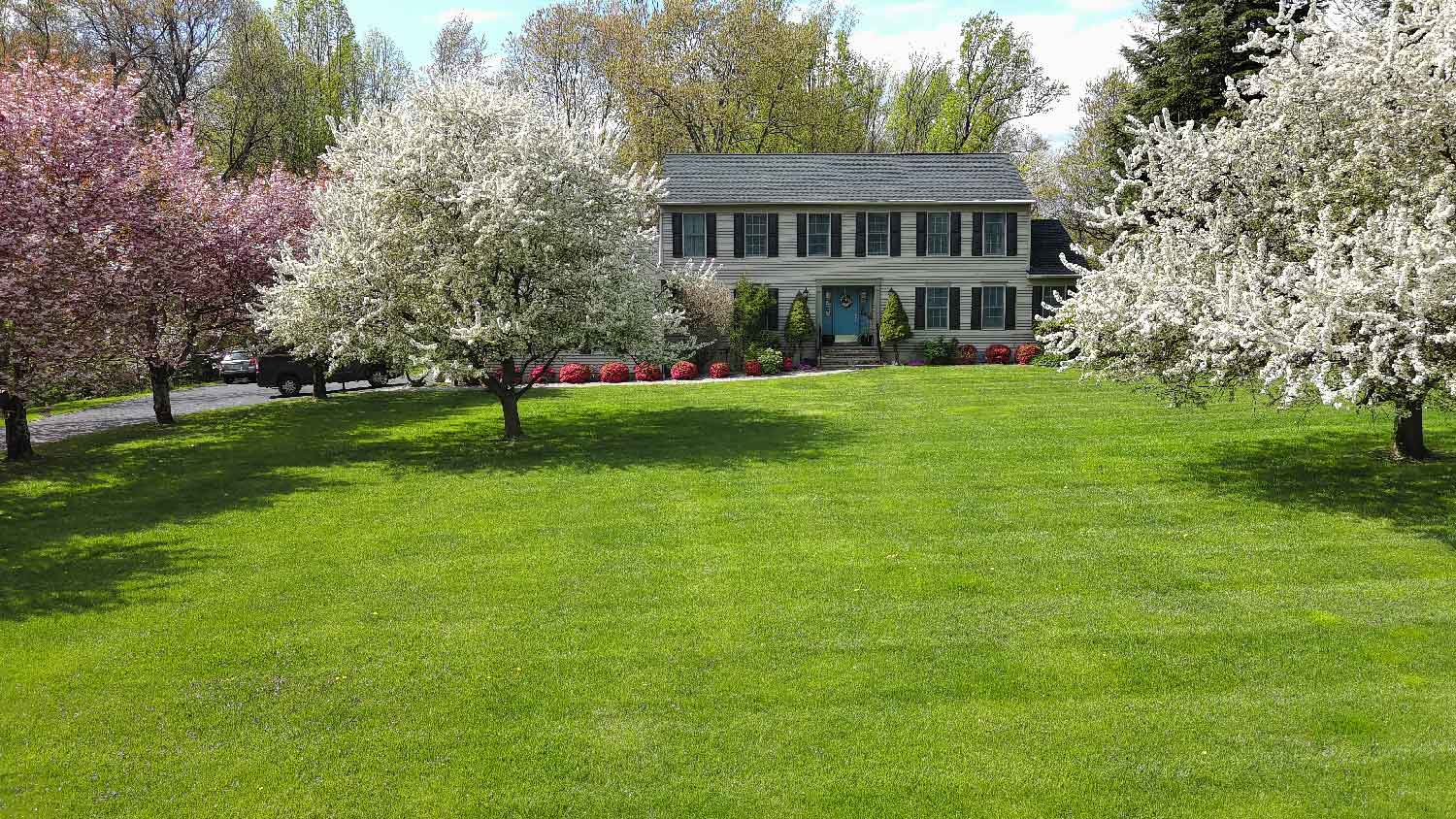How to Charge for Lawn Mowing: Pricing Tips and Pricing Chart for Lawn Care Pros
Set prices that are both profitable and fair to keep customers coming back


Most lawn care professionals charge between $50 and $250 to mow a lawn, or $30 to $65 per hour.
If you add maintenance costs, your rates may increase to $125–$450.
Calculate your mowing time and the lawn size to determine prices.
Per hour is the most reliable method that factors in the unexpected.
Pricing lawn mowing fairly and competitively comes down to knowing local rates for lawn care and estimating the complexity and time it will take for your lawn care job. You won’t want to price all jobs the same, or you’ll risk losing money.
It can take a bit of time to figure out how much to charge to mow a lawn in a balanced way that perfectly serves all parties involved, but we’ve got expert insight to help take away some of the guesswork. Take a look at a few factors that determine the average cost of lawn care and how you should figure out pricing for your services.
How Much to Charge for Lawn Care Services
On average, lawn care professionals charge between $30 and $65 per hour. If you choose to charge a flat fee for lawn mowing, the average falls between $50 and $250.
More specialized landscape maintenance, like weed control, trimming, aeration, fertilization, and pesticide treatment, average between $125 and $450 for a flat fee.
When customers book complete lawn jobs, they understand they're paying for both time and expertise. As a lawn professional, your experience can turn lawns into park-like settings using the right equipment, blades, and edging techniques, making your work valuable.
The pricing chart and lawn mowing pricing models further below can help you get a better idea of what’s a reasonable price to charge for your services.
Lawn Mowing Pricing Chart
Providing a pricing chart is one way to break down your costs for potential customers. That way, they can look at the chart and consider their lawn care needs and budget. Convenience is the name of the game here.
The lawn care pricing chart below is an example of how you might want to break down lawn mowing costs by lawn size and typical mowing time.
| Lawn Size | Estimated Time | Cost |
|---|---|---|
| 1/4 acre | 15 min. – 30 min. | $25 – $60 |
| 1/2 acre | 30 min. – 1 hr. | $50 – $75 |
| 1 acre | 1 – 2 hrs. | $150 – $200 |
| 2 acre | 2 – 4 hrs. | $250 – $350 |
| 3 acre | 3 – 6 hrs. | $350 – $500 |
| 5 acre | 5 – 10 hrs. | $450 – $650 |
| 1 acre | 10 – 100 hrs. | $500 – $750 |
Different Lawn Mowing Service Pricing Models
Every lawn care job will have its own pricing model, depending on the level and kind of work it involves. For example, it’s perfectly acceptable to charge a premium for larger, complex, or time-consuming jobs. Just make sure you're transparent about your pricing model when you provide an estimate.
The first step to deciding how to charge clients is determining how much you need to make per hour across all jobs. That doesn't mean you're actually charging by the hour. It just means that you have an idea of the hourly breakdown that makes a job worthwhile.
You'll need to know how much each job will bring in per hour while factoring in your overhead costs, even if you charge a flat or project-based rate.
Per Hour
An hourly rate is the most straightforward option when you’re charging someone to mow their lawn. Lawn mowing prices per hour for most pros sit between $30 and $65, and much of this variation depends on experience and specialized offerings.
Let's say you charge $50 per hour. The average lawn in the United States is somewhere around 10,000 square feet. If it takes you two hours to mow the entire lawn, you'll earn $100 ($50 multiplied by 2).
The benefit here is that you're compensated for your time if some lawns take longer due to complicated terrains. You also don't have to try to work out how long prep and cleanup times will take ahead of time like you would with a "package price." Instead, you'll be charging for all the time you spend at the property.
Charging by the hour can be a smart move for new lawn professionals. This is because it’s hard to estimate how long it will take you to complete a job at first. If you rush into flat rates or project rates, you risk losing money on clients by underestimating how long projects will take.
Per Square Foot
Some lawn care professionals prefer to charge by square footage. They may use aerial footage of properties when creating estimates to get a feel for how complex the job will be. The complexity of a project is important because it's very easy to lose money by charging the same rate per square foot for each customer when terrain can vary wildly.
Make sure you get your desired hourly rate when creating estimates based on square footage.
Let's say you want to make $50 per hour and a customer with a lawn that's 10,000 square feet contacts you. You'll need to have a really good idea of how many hours it would take you to get that much square footage mowed.
Now let's say you know it takes exactly two hours to mow 10,000 square feet. You should charge $0.50 per square foot to reach your goal of making $50 per hour.
The perk here is that customers love this no-nonsense approach to lawn mowing pricing. Plus, you'll like that you can enjoy predictable revenue.
However, the problem with charging by square footage is that it doesn’t account for special circumstances. For example, you could run into a situation where a specific 10,000-square-foot lawn takes you an extra 30 minutes due to hilly terrain. Unfortunately, you’ll have to eat that extra $25 in labor if you didn't take a look at the property first to increase your price per square foot. You could lose hundreds per week if you miscalculate several times.
Flat Fee
A flat fee allows you to charge a single price for a complete project. Charging with a flat fee can work in a few different ways.
First, flat fees are great for recurring lawn mowing jobs. Customers will appreciate the consistency of paying a flat monthly or weekly rate for regular mowing. This also allows you to set up auto payments for recurring customers.
Additionally, you might want to provide flat fees for larger projects to make it easier for customers to budget for the job.
Again, being successful with this comes down to knowing how much you need to earn per hour to make a job profitable. If you're looking for $50 per hour, you need to know two things: how much work you can do in each hour and how many hours the job will take.
Here's a sample project:
Mowing time: 55 minutes
Trimming: 15 minutes
Edging: 10 minutes
Blowing: 10 minutes
Say this is a 90-minute job. If you need to make $50 per hour to be profitable, you'll have to charge at least $75 for the entire project.
The downside to the flat fee is similar to the downside of charging per square footage. You may lose money if you're not totally on the ball with your estimate. What's more, you could be losing money day after day if you've charged a flat rate that's too low for a big project.
Additional Mowing Services to Consider

Lawn care companies that offer premium services can charge more both hourly and per job. Consider adding value to your service by bundling even more useful services into your packages.
Here are a few service-based strategies to set yourself apart from the competition:
Use eco-friendly materials.
Offer waste removal, weeding, and fertilizing services.
Install landscape lighting.
Upsell with insect, disease, and pest control.
Offer snow and ice removal in the winter.
One of the most important strategies to keep in mind is treating returning customers very well. You shouldn’t forget about rewarding loyalty, as most of your revenue will come from a small fraction of repeat customers.
Offer incentives for clients who book regular mowing, such as $5 off per week.
Provide discounts to repeat customers, like free weed pulling after 20 mows.
Give small gifts (like a flower bulb) to customers once they’ve reached a certain milestone.
Rewarding loyal customers with lower prices helps keep the competition from swooping in with a deal. Loyal customers are also easier to upsell, which can be more profitable than always pursuing fresh leads.
What to Consider When Charging for Lawn Services
When you decide on the price per hour needed to be profitable, make sure you're accounting for all necessary costs, from lawn size to overhead.
Here are some crucial lawn mowing business costs to consider:
Overhead
When you run a lawn business, you must factor overhead and operational costs into your price per hour. Start by actually determining what your monthly overhead adds up to based on your expenses. Your overhead includes everything from equipment costs to monthly premiums for business insurance.
Next, determine how much of that total cost for overhead you need to factor into each job. You can do this by essentially dividing the overhead amount by the average number of jobs you book per month.
Taxes
Equipment purchases and rentals, miles driven, depreciation, wages to employees, and payments to independent contractors are all tax-deductible. In fact, almost every business expense is tax-deductible, including phone and internet bills if you’re using them for your business. Be sure to keep detailed records so you can get the most deductions come tax time.
Weather
If you live in a colder climate, you already know that landscaping notoriously has a low season in the winter. Unfortunately, many of your overhead costs related to maintaining vehicles, owning equipment, and keeping insurance will still apply when the calls aren't coming in. You may need to bake costs related to the slow season into your rates during peak seasons.
Try to "winterproof" your lawn care business by providing services that go beyond mowing.
Here are some services that can keep you afloat when mowing demand slows:
Draining sprinklers
Dethatching lawns
Wrapping trees in burlap
Planting bulbs
Seeding
Mulching/pine straw
Pressure washing
Many landscapers also offer plowing and sidewalk shoveling. Clients who don't mow their own lawns often prefer not to shovel their driveways. It's possible to turn summer regulars into winter regulars every time it snows.
Location
Prices of goods and services vary by state. That means you have to price your services by the regional average instead of the national average. If you work in an area with a consistent climate, you can charge less because you don't need to buy equipment that's compatible with all four seasons.
However, the flip side is that mowers and trimmers are likely to get worn out faster in places where mowing is necessary for most of the year.
Labor
If you have a crew, a big portion of your overhead is wages. You're looking at the total cost based on the number of hours needed times the number of people needed when providing estimates.
When you deliver estimates, make sure you include the number of workers in your itemized list to justify what you charge.
Steps to Calculate Lawn Care Pricing
Lawn care pricing can be complex to calculate, but once you choose the calculations that work best for your business, you’ll have rates that accurately reflect your work. Here’s how you can calculate your lawn care prices:
1. Choose a Model
Again, there are three main pricing models for lawn care services: by the hour, by square footage, and by flat rates.
| By the Hour | By Square Footage | By Flat Rate |
|---|---|---|
| Adaptable to different job complexities | Provides a straightforward estimate for customers | Ensures consistency for recurring customers |
| Can lead to unpredictable final cost | Can result in a loss of income if you miscalculate the lawn’s complexity | Can result in a higher cost for smaller or less complex jobs |
| Best for new lawn care pros and variable jobs | Best for larger lawns with uniform size and terrain | Best for routine maintenance |
2. Consider All Expenses
Once you’ve chosen a method for calculating your prices, you’ll also need to consider any additional costs that might pop up. This will help cover any surprises like tall grass, sloped land, rocky terrain, and more. It’s also important to include the costs of common add-ons for lawn care services, including:
Fertilization costs: $75–$400
Aeration costs: $0.10–$0.35 per square foot
Yard cleanup costs: $190–$1,000
Tree trimming costs: $200–$750 per tree
Reseeding costs: $0.10–$0.20 per square foot
3. Create a Pricing Package
With all of your cost factors and your charging method in place, you can finally stop watching the grass grow and start creating the perfect package for your lawn care business.
Customers like options, so consider the numbers you came up with and create different packages that fit within your price range to give your customers a choice. It’s also a good idea to compare your calculations to other lawn care services in your area to make sure your prices are competitive.
How to Grow Your Lawn Care Business
As a lawn care professional, charging the right price is essential to making a profit and growing your business. It’s important to calculate your expenses, including labor, equipment, and overhead, to set rates that sustain your business. You can leverage these calculations to give customers transparency about what they’re being charged and build trust.
Once you’ve established a rate, here are some tips to help grow your lawn care business:
Offer seasonal packages such as spring clean-up, summer maintenance, and fall leaf removal to keep customers engaged year-round.
Invest in high-quality equipment to reduce downtime.
Offer referral discounts.
Use online services, like Angi, to reach a broader audience and bring in new customers.
Sign up for Angi Ads today to get leads actively looking for lawn care services in your local area. From helping you manage leads to accepting payments, Angi is a lawn care professional’s secret weapon.
Frequently Asked Questions
Starting a mowing business can be profitable if you manage your business wisely, calculate costs accurately, and invest in time-efficient, high-quality equipment. With good customer service, you can lock in loyal customers who invest in weekly lawn care services that turn your business into a successful one.
Lawn care businesses can earn anywhere from $40,000 to over $100,000 per year depending on how you operate, but you’ll need to factor in the cost of equipment to determine your actual profit margins.
Depending on your lawn mower type, you can mow anywhere from 2.5 to 13 miles per hour (mph). A simple push lawn mower will take the longest to mow at 2.5 mph, which is just under the average walking pace. Riding mowers can go significantly faster. Rear engines come in at around 5 mph, tractors come in at just shy of 8 mph, and zero-turn mowers come in at the fastest speed of 13 mph.





- House Cleaning Pricing Guide: What to Charge for Your Cleaning Services
- How Much to Charge for Painting Jobs Big and Small: A Pricing Guide for Pros
- How to Hire the Best Lawn Service
- Who To Call for Lawn Problems: A Complete Guide
- Can You Overwater Grass? How to Avoid This Common Mistake
- How Much Does Lawn Removal Cost? [2024 Data]
- 10 Easy Ways to Save Money on Lawn Care
- How to Be a Successful Landscaper: 6 Tips for Business Owners
- Spring Lawn Care: 15 Easy Steps to a Beautiful Yard
- How To Mow a Lawn: A Complete Guide










